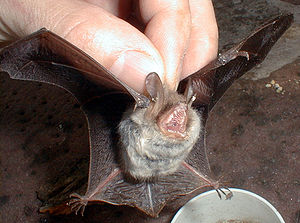Myotis nattereri
Rare and Endangered Animals of Armenia
The Gray Bat
The Gray Bat (Myotis grisescens) is a small bat that lives in caves throughout the southern United States. It usually chooses caves which are located within one mile of a river or reservoir.
The gray bat weighs 7 - 9 g (0.2 - 0.3 oz). Its diet consists predominantly of insects. All species of the genus Myotis, including the gray bat, roost by day and forage at night. They often hunt and feed over water. The feeding flights usually alternate with periods of rest, during which the bats hang to digest their catch. Colonies of the gray bat travel up to 6.6 km (4.1 miles) from roost to foraging areas. The gray bat has a wingspan of about 11-12 inches and is uniformly dark gray.
Gray bats use warm caves in the summer where they establish maternal and bachelor colonies. Few have been found roosting outside caves. In the winter they relocate and hibernate in a few small cold caves.
The range of the endangered gray bat is concentrated in the cave regions of Arkansas, Missouri, Kentucky, Tennessee, and Alabama, with occasional colonies and individuals found in adjacent states. The species' present total population is estimated to number over 1,500,000; however, about 95 percent hibernate in only eight caves--two in Tennessee, three in Missouri, and one each in Kentucky, Alabama, and Arkansas.
Although gray bat numbers are still relatively high, their total population has decreased significantly during recent years. The gray bat is thought to have declined mainly due to destruction by vandals and disturbance by spelunkers and tourists.
This gray bat has been declared an endangered species.
The following disclaimer relates only to the text above this line
This article contains content from Wikipedia, used here under the GNU Free Documentation License.
Animal in Armenia
Նատերերի արաքսյան գիշերային չղջիկ ("Natereri araksian gisherain chghjik")
Status
In former Soviet Union territory only in Armenia and Nakhichevan is met.
Habitat in Armenia
Yeghegnadzor, Vayk and Meghri regions.
Number in the wild
A group of 12 species is discovered in 1946. Nowadays the number in the groups does not exceed 5 – 6. Most frequently are met alone or in groups of 1 – 2.
Reasons for decrease in number
No data
Number in captivity
No data
Measures of protection taken
None

